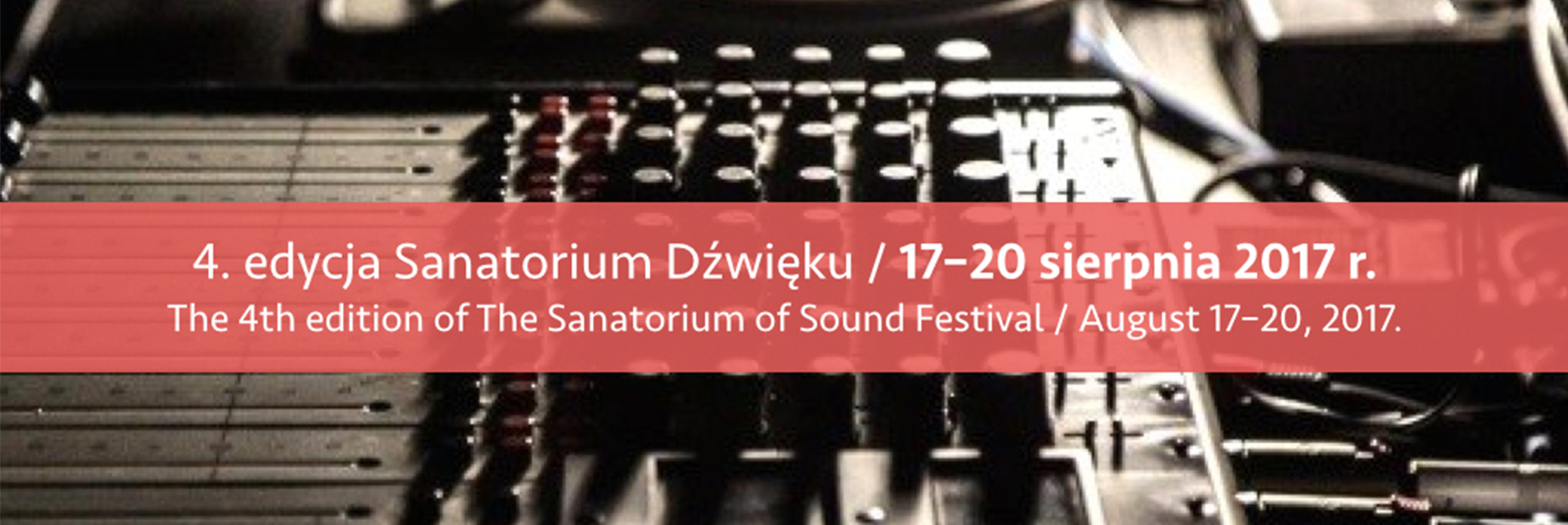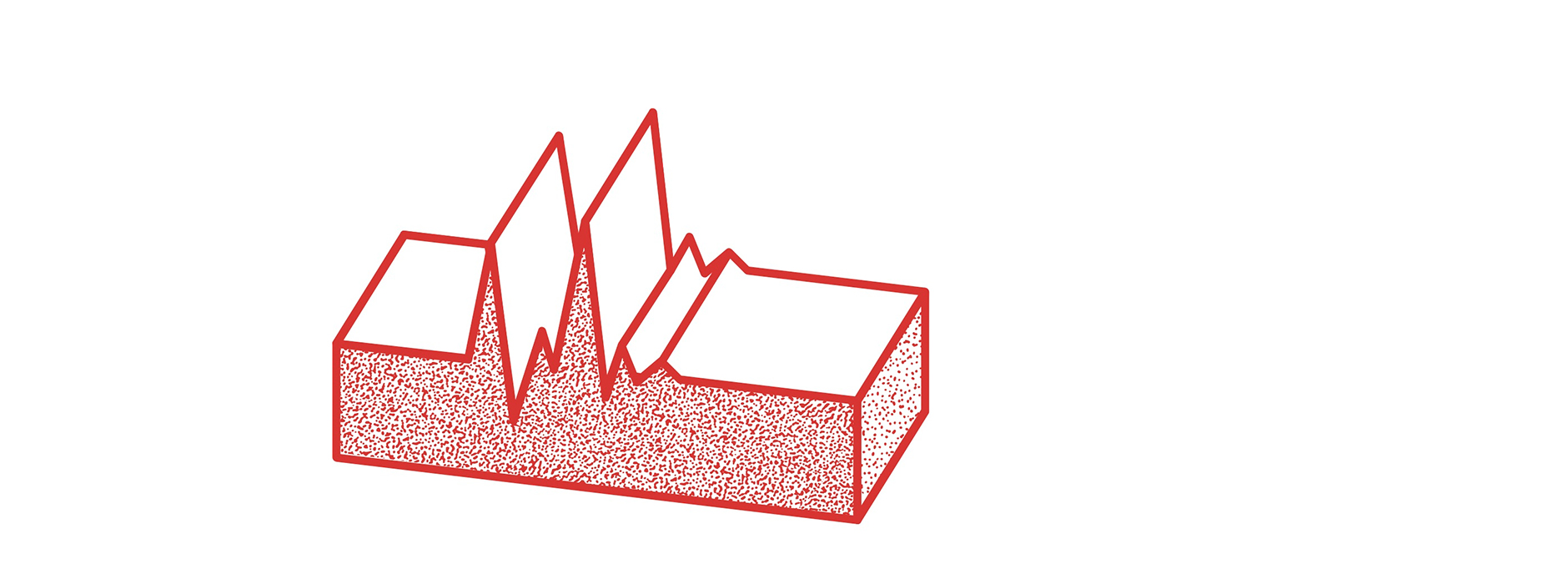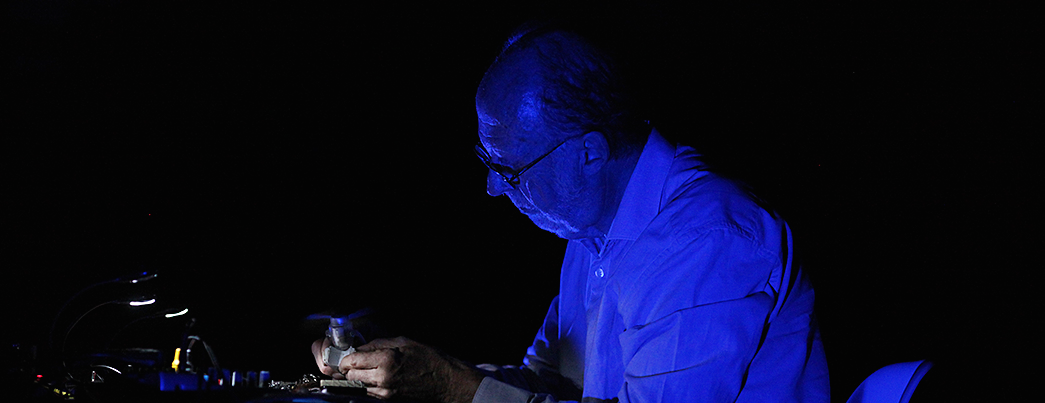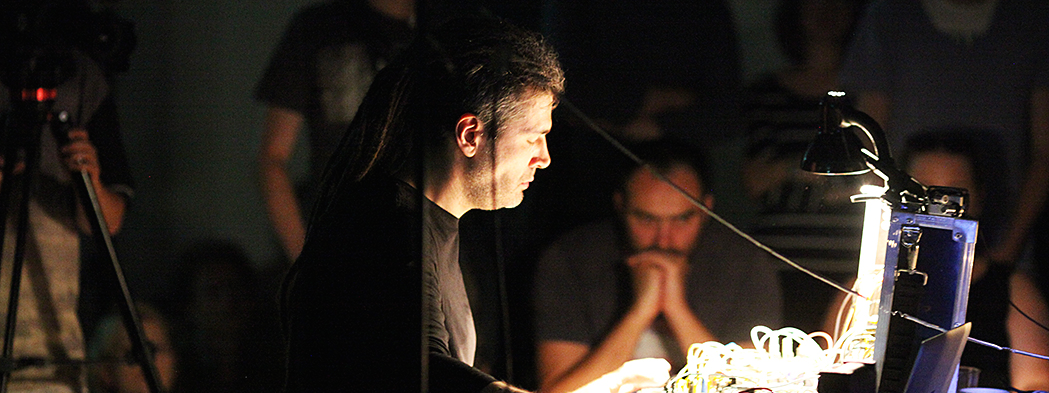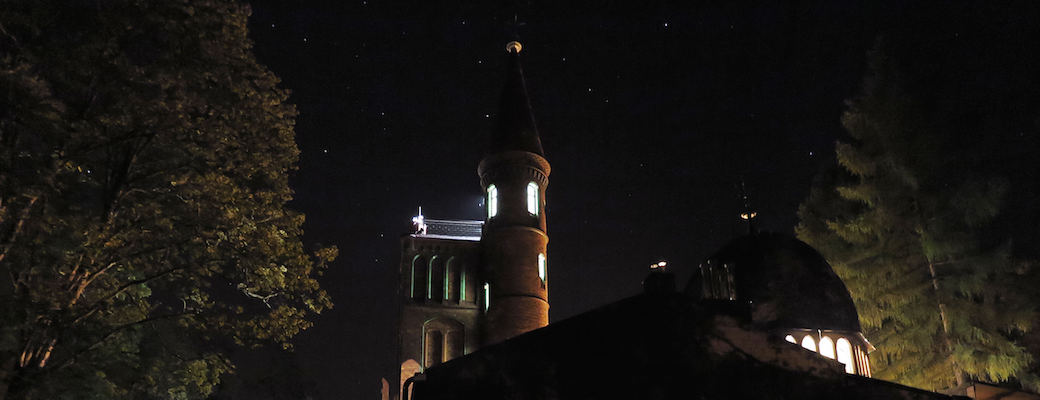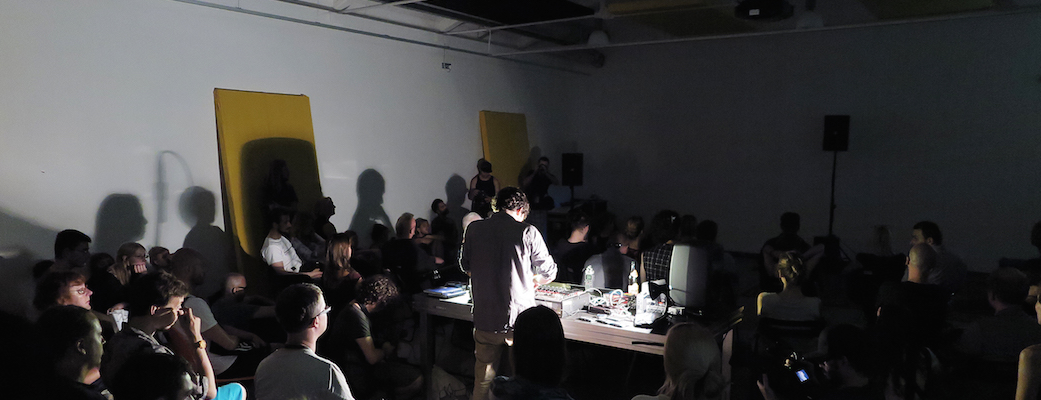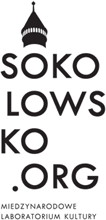




13 August / SATURDAY / 19.00–19.30 / Park
“The Fall of Recording”: Keith Rowe / Gerard Lebik – „Dry Mountain”
Performed by: Emilio Gordoa / Bryan Eubanks / Xavier Lopez / Jonas Kocher / Gaudenz Badrutt / Johnny Chang / Mike Majkowski
Visual works by: Bożenna Biskupska, Radek Szlaga, Alicja Bielawska, Daniel Koniusz
“Dry Mountain” which has been founded last year with Gerard Lebik, when the two musicians recorded their improvisations and created a score from the selected, several-minutes-long fragment. The composed piece will be interpreted by instrumentalists invited to perform it: Johnny Chang, Mike Majkowski, Bryan Eubanks, Xavier Lopez, Jonas Kocher, Gaudenz Bardutt, Emilio Gordoa and Piotr Damasiewicz, as well as visual artists (Bożenna Biskupska, Radek Szlaga, Alicja Bielawska, Daniel Koniusz), who will create further graphical scores to enable performances in various instrumental configurations. The project as a whole conforms to the broader tendency for experimentation in the fields of musical notation and the interference of different artistic disciplines.
Keith Rowe (born 16 March 1940 in Plymouth, England) is an English free improvisation tabletop guitarist and painter. Rowe is a founding member of both the influential AMM in the mid-1960s (though in 2004 he quit that group for the second time) and M.I.M.E.O. Having trained as a visual artist, Rowe’s paintings have been featured on most of his own albums. After years of obscurity, Rowe has achieved a level of relative notoriety, and since the late 1990s has kept up a busy recording and touring schedule. He is seen as a godfather of EAI (electroacoustic improvisation), with many of his recent recordings having been released by Erstwhile Records. Rowe began his career playing jazz in the early 1960s—notably with Mike Westbrook and Lou Gare. His early influences were guitarists like Wes Montgomery, Charlie Christian and Barney Kessel.[1] Eventually, however, Rowe grew tired of what he considered the form’s limitations. Rowe began experimenting, slowly and gradually. An important step was a New Year’s resolution to stop tuning his guitar—much to Westbrook’s displeasure. Rowe gradually expanded into free jazz and free improvisation, eventually abandoning conventional guitar technique.
This change in his approach to guitar, Rowe reports, was partly inspired by a teacher in one of his painting courses who told him, “Rowe, you cannot paint a Caravaggio. Only Caravaggio can paint Caravaggio.” Rowe reports that after considering this idea from a musical perspective, “trying to play guitar like Jim Hall seemed quite wrong.” For several years Rowe contemplated how to reinvent his approach to the guitar, again finding inspiration in visual art, namely, American painter Jackson Pollock, who abandoned traditional painting methods to forge his own style. “How could I abandon the technique? Lay the guitar flat!”
Rowe developed various prepared guitar techniques: placing the guitar flat on a table and manipulating the strings, body and pick-ups in unorthodox ways to produce sounds described as dark, brooding, compelling, expansive and alien. He has been known to employ objects such as a library card, rubber eraser, springs, hand-held electric fans, alligator clips, and common office supplies in playing the guitar. A January 1997 feature in Guitar Player magazine described a Rowe performance as “resemble a surgeon operating on a patient.” Rowe sometimes incorporates live radio broadcasts into his performances, including shortwave radio and number stations (the guitar’s pick-ups will also pick up radio signals, and broadcast them through the amplifier).
AMM percussionist Eddie Prévost reports that Rowe has “an uncanny touch on the wireless switch”, able to find radio broadcasts which seem to blend ideally with, or offer startling commentary on, the music. (Prévost, 18). On AMMMusic, towards the end of the cacophonous “Ailantus Glandolusa”, a speaker announces via radio that “We cannot preserve the normal music.” Prevost writes that during an AMM performance in Istanbul, Rowe located and integrated a radio broadcast of “the pious intonation of a male Turkish voice. AMM of course, had absolutely no idea what the material was. Later, it was complimented upon the judicious way that verses from The Koran had been introduced into the performance, and the respectful way they had been treated!” In reviewing World Turned Upside Down, critic Dan Hill writes, “Rowe has tuned his shortwave radio to some dramatically exotic gameshow and human voices spatter the mix, though at such low volume, they’re unintelligible and abstracted. Rowe never overplays this device, a clear temptation with such a seductive technology – the awesome possibility of sonically reaching out across a world of voices requires experienced hands to avoid simple but ultimately short-term pleasure. This he does masterfully, mixing in random operatics and chance encounters with talkshow hosts to anchor the sound in humanity, amidst the abstraction.”
Some accounts report that Rowe’s guitar technique was an influence on Pink Floyd founder Syd Barrett: “Taking his cues from experimental guitarist Keith Rowe of AMM, Barrett strived to push his music farther and farther out into the zone of complete abstraction.”[6]
Rowe has worked together with numerous composers and musicians, including Cornelius Cardew, Christian Wolff, Howard Skempton, Jeffrey Morgan, John Tilbury, Evan Parker, Taku Sugimoto, Otomo Yoshihide, Sachiko M, Oren Ambarchi, Christian Fennesz, Burkhard Beins, Toshimaru Nakamura, David Sylvian and Peter Rehberg.
http://efi.group.shef.ac.uk/musician/mrowe.html
Gerard Lebik – musician, sound artist, living Wroclaw/Poland. Works with improvised, experimental and intermedia music. H’s the author of sound installations and sound interventions in public space. Creates by improvisation, musical notation or through directly manipulation of sonic material using electro and acoustic media. Explores the audible phenomena field through various tools and techniques: saxophones, zopan wave generators, air compressors, VHS recorders, video objects, electronics, analog video feedback, software. In 2007 graduated Wroclaw Academy of Music.
Performed with: Phil Minton, David Maranha, Eryck Abecassis, Keith Rowe, Paul Lovens, Kazuhisa Uchihashi, Jerome Noetinger, Noid, Brian Labycz, Hernani Faustino, Kurt Liedwart, Miguel A Garcia, Ilia Belorukov, Gabriel Ferrnandini, Noritaka Tanaka, Bettina Wenzel, hans w koch, Joker Nies, Rodrigo Pinheiro, Christian Marien, Pawel Janicki, Piotr Damasiewicz, Artur Majewski… and others
Events: Kunsthale Basel, Mem Bilbao, LulCec Barcelona, V:NM-Festival in Graz, Bienale Zagreb, TodaysArt Festival Hague, Tokyo Jazz, Festival Umbrella Chicago, Musica Electronica Nova, Sibiu Jazz and More, Avant Art, Musica Electronica Nova, Musica Polonica, Survival Art Review, SuperDeluxe-Tokyo, Alte Feuerwache- Cologne, CSW-Warszawa, Galeria Kordegarda, De Werf-Brugge, Pit Inn Shinjuku-Tokyo, Ftarri-Tokyo, Quite Que-Berlin…
http://www.gerardlebik.com/gerardlebik.html
Artistic Director and Curator Sanatorium Dźwięku Festival/Platform Sokołowsko.
http://gerardlebik.blogspot.com
http://2016.sanatoriumdzwieku.pl/e
Realization takes place as part of the A-I-R Sanatorium of Sound Sokołowsko implemented in cooperation with the Artist-in-Residence Programme A-i-R Wro. The A-i-R Wro Programme is a part of the European Capital of Culture Wrocław 2016 and is subsidized by the Ministry of Culture and National Heritage of Poland.
A-I-R Sanatorium of Sound 2016 is a residency program for composers, improvisers and sound artists, creating a platform for contemporary music and broadly understood sound art. One of the program tasks is to support new, creative curatorial practices relating to the topic of sound and music, as well as the search for meaning in the intersection of art and technology.
The program is run in within the Artist-in-Residence Programme A-i-R Wro, part of European Capital of Culture Wroclaw 2016. The invited artists will take part in a two-week residencies in Sokołowsko, which effects (such as compositions, sound installations or theoretical works) will be presented also at the third edition of the Sanatorium of Sound Festival, held in Sokołowsko on 12-14th August 2016.
Artists invited to AIR Sanatorium of Sound 2016: Keith Rowe, Michael Pisaro, Olivia Block, Valerio Tricoli, Alessandro Bosetti, Mario de Vega, Martin Howse, Stephen Cornford.
Curators of AIR Sanatorium Sound 2016: Gerard Lebik, Michał Libera, Zuzanna Fogtt.
Artist-in-Residence Programme A-i-R Wro is co-financed from the funds of the Ministry of Culture and National Heritage of Poland
Concert takes place as part of the A-I-R Sanatorium of Sound Sokołowsko implemented in cooperation with the Artist-in-Residence Programme A-i-R Wro. The A-i-R Wro Programme is a part of the European Capital of Culture Wrocław 2016 and is subsidized by the Ministry of Culture and National Heritage of Poland.
